Deytsiya is a genus of perennial shrubs from the family Hortensia, height from 50cm to 4m, among the 72 species are deciduous and evergreen. Gardeners appreciate the long (up to 35 days) and very abundant flowering in late spring - early summer, as well as the shape of the bush - in most species it looks like a dome, slightly smaller in width than height.
Lives this plant about 25 years. Flowers are white, pink, sometimes - red, simple or terry, mostly odorless. Often used as a hedge, because it calmly carries smoke, or freestanding bushes. Even fragrant species are completely safe for people with allergies. In the green form, not in the period of flowering, the action is easily confused with honeysuckle.
The most common types and varieties
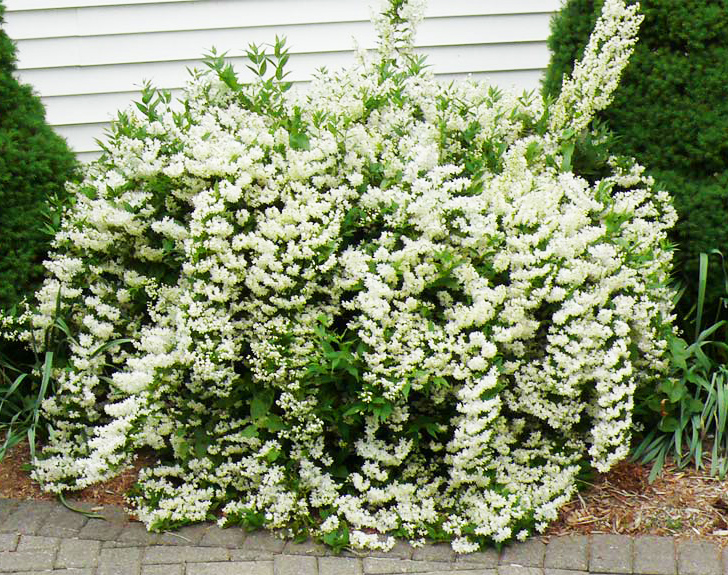
Growing conditions and care
Deytsiya is a very demanding plant, and in order for it to live long and be beautiful, provide it with the following conditions:
- Lighting and humidity ideal for action in the penumbra from tall trees with openwork crown. Such neighbors will protect the bushes from direct sunlight, but they will leave a long-lasting level of illumination and keep moisture in the air. If there is no possibility of such a neighborhood - it is better to choose the sun than a thick shadow.
- Northern cold wind and draft also undesirable for action, so it’s better to look for a place for it in the south of the house or other building.
- Groundwater , located very close to the surface of the earth also will not allow the development of deuterium for a long and fully.
- When choosing a place for action, consider also its possible dimensions in 5-7 years: it is better that within a radius of 1-2,5m nothing grows (depending on the variety and how you cut it).
- Soil prefer fertile, can be loamy, but drained, because This plant does not tolerate stagnant moisture in the ground. The ideal blend for mature plants is a combination of humus, river sand and peat (or compost) in a 2: 2: 1 ratio. Neutral acidity is desirable (pH 5-8).
- Watering produce regularly from April-May to mid-August, an average of 10 liters per plant 1 time per week, and in dry arid weather - 20 l each. Large bushes and hedges are watered at the rate of 30 - 40 liters per 1 m. sq.
- Loosening carried out after watering to a depth of 20 - 25 cm, simultaneously removing weeds. To avoid this procedure will help mulching the root circle.
- Pruning carried out twice a year: in spring and summer, after flowering. In the spring, they only carry out sanitary trimming - they remove frozen and dry branches, as well as broken and trampled. The main pruning is carried out immediately after flowering, so that the plant has time to recover. To do this, all shoots are shortened by 1/3, simultaneously adjusting the shape of the bush. If you are absolutely not satisfied with the form of your action - safely cut it to the ground, leaving only a stump. This stimulates the active growth of basal shoots, and next year you will receive a new lush bush.
- Feed up The action is abundant at planting, and then only during the flowering period, once a month, 3-4 l of liquid manure per plant. Additionally, it is desirable to feed 2 times a season with complex mineral fertilizer with 100-150g per shrub.
- Shelter for the winter different is required for different varieties and regions.
- To frost-resistant varieties it is enough to mulch the radical circle with fallen foliage, straw or spruce branches.
- If the plant is an adult, with upright shoots, tie its branches with string or twine, and wrap with a covering material on top - sackcloth, spandbond or lutrasil.
- Youngsters and bushes with a round crown can be bent to the ground, above them build a frame, cover it with spruce spruce branches or fallen leaves, cover with lutrasil, and the last layer - film.
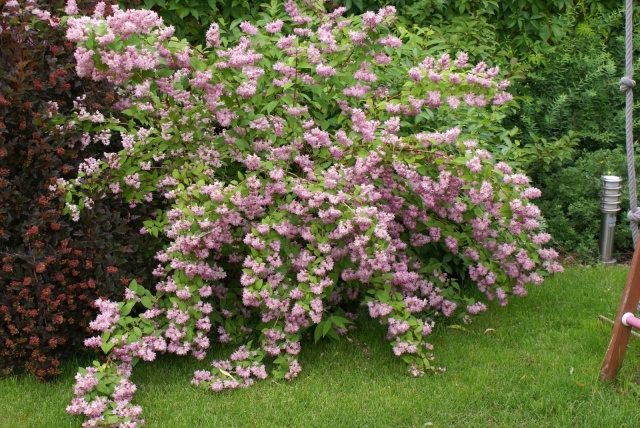
Do not forget to remove the shelter in early April so that the action blossomed on time.
Planting and reproduction
Young deitia are planted only in early spring, when buds have not yet blossomed on the trees. For this, pits are prepared 35-60 cm deep (the poorer the soil, the deeper) at a distance of 1.5 m from each other. If the plant is 1 - 3 years old, the roots are pinched for greater bushiness. I drain the bottom of the pit with sand or broken brick, put a seedling on it, straighten the roots horizontally and cover it with suitable soil (see growing conditions and care). Fertilizers are added to the soil: about 10 liters of compost and 100 g of nitrophoska per plant. The root neck can be recessed no more than 2 cm. Bottom circle mulch peat layer about 5 cm.
The easiest way to reproduce is cuttings by cuttings (rooted about 90%) or root sprays, but reproduction by seeds, dividing a bush and layings is also possible.
- Green cuttings are cut in May-June. To do this, cut off 8 - 10 cm from large, mature shoots. The cut will not be superfluous to treat the root formation stimulator. For the soil mix, they combine equally nutritious soil (for example, sand peat) with river sand. Cuttings deepen to 0.5 cm with a slight slope and sprinkle 2-3 cm layer of sand. By planting on a permanent place saplings are ready only in 2 years.
- Lignified cuttings are harvested in the late autumn, during the dormant period of the plant. Cut cuttings 15–25 cm, 3–5 buds on each, bundle 10–15 pieces in a bundle and vertically, almost completely covered with moist sand. Stored until spring in the basement, and then grown the same as green cuttings.
- Divide the bush, too, only in spring. To do this, it is completely dug, remove the old branches, thin out and divide into 2 - 3 parts. Repot as quickly as possible, so as not to have time to dry up the roots.
- Root offsprings can be separated without digging up the entire shrub, and also quickly transplanted into the prepared pit.
- The seeds of the deytion ripen in October in the fruit - boxes, they are pulled out and stored until spring. The seeds are sown in light fertile soil (peat, humus and river sand in equal proportions), superficially, and sprinkled on top with a thin layer of clean sand. Crops well moistened and covered with glass or transparent film. Shoots should be expected in 1 - 1.5 months. Juveniles dive with well-developed leaves immediately in open ground.
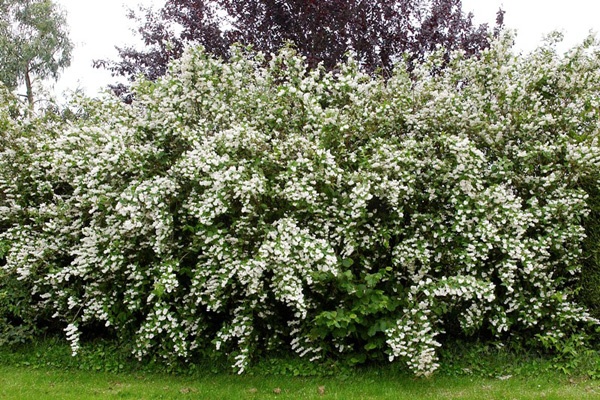
Diseases and pests
Deytsiya is a very disease-resistant plant, but occasionally it can be affected by aphids and leaf spotting. And if suddenly the leaves of your bush are eaten by a bumblebee-shaped proboscis, process it with a 15% solution of phthalophos or karbofos.
|
Latin name: Deutzia scabra Family: Hortensia |
Deytion rough, or stellate (lat. Deutzia scabra) - ornamental shrub of the Deice family of the Hortensia family. In nature, it is found in China and Japan. The plant got its name for rough leaves, covered over the entire surface with small hairs.
Characteristic culture
Deytion rough, or stellate - deciduous shrub up to 2.5 m with gray-brown or reddish-brown shoots. The leaves are dull, green, ovate or oblong-ovate, rough-pubescent, up to 8 cm long. In autumn, the foliage becomes yellow-brown or golden-yellow. The flowers are pinkish, light crimson, purple, carmine or white, star-shaped, gathered in erect narrow paniculate inflorescences.Today in nurseries varieties with double flowers are represented, they are distinguished by abundant flowering, often the shoots do not withstand the gravity of numerous flowers and bend, as a result, the plants acquire a weeping shape. There are varieties with variegated leaves.
Deytion rough, or stellate heat-loving, can not boast of frost resistance. Under conditions of the Moscow Region, it winters only under cover, otherwise it freezes to death. Crops bloom in July and August, the fruits ripen in October. Easily propagated by seeds and cuttings. Deutzia rough blooms in the third year after landing.
Growing conditions
Deytion rough or stellate rather demanding on growing conditions. It develops best in soils rich in mineral and organic matter with moderate moisture. Suitable for growing crops are drained, light, loose, water- and breathable substrates, the content of lime is not forbidden. The location is preferably sunny, the light open shadow does not harm, but in this case the plants will not be pleased with abundant flowering.Breeding
The deedia is propagated by rough, or stellate, seeds and vegetatively (green and lignified cuttings, layering and root suckers). Sowing seeds carried out in the spring without prior preparation. Seeds scatter on the surface of the soil without embedding, gently pressing against the surface of the soil.Shoots appear in 3-4 weeks. Seedlings dive in phase 3 of these leaves. For winter, seedlings need shelter. Young plants are transplanted to a permanent place in the second year. No less effective for the action of green cutting. Cut cuttings in the middle of summer. Rooting is planted in greenhouses with light, air-permeable nutrient soil.
Care
Deytion rough or stellate heavily tolerates heat and prolonged drought; these periods require abundant and regular watering without waterlogging. In ordinary summer, shrubs are watered 1-3 times a month at the rate of 15-20 liters per 1 adult plant. The culture responds well to loosening, weeding and fertilizing. Mulching is optional, but welcome, especially for young specimens.Pruning is carried out immediately after flowering, this procedure promotes better growth and active development. Also periodically carry out anti-aging and thinning pruning. No thickening should be allowed. Hedges their actions do not subject to shearing. In winter, the shrubs bend down to the soil surface, covered with spruce leaves or other non-woven modern material.
Ideal for dressings: slurry, phosphate, potash and nitrogen fertilizers. Mineral fertilizers are applied after pruning and at the end of summer, organic - in early spring. With pests and diseases, deuterium rough or stellate disease is rarely affected, but prophylactic treatments with natural infusions are desirable.
Using
Deytion rough, or stellate - culture flowering, which is why it is widely used in ornamental gardening. It is used to create various landscape compositions. The plant is perfect for the formation of hedges and design borders.Deytsia looks great in single and group plantings. Allies of the plant can be lilac, hydrangea, weigela and other flowering shrubs, as well as fan maple, Thunberg barberry, white mulberry, henomeles and leather tannery. Herb plants and flower cultures, for example, geyhery, bouzulniki and doronicum, will add a highlight to the abundant-flowering compositions.
In the genus "deytsiya" there are about 50 species that are assigned to the family of hydrangea. Under natural conditions, deations occur in Asia, in North America, in some regions of Eastern Europe. In the Russian Federation, they are in the south of Khabarovsk and Primorsky Krai. Part of the action is shrubs or dwarf shrubs, but there are some herbaceous plants and creepers. The root system of actions can be characterized as a fibrous rod: there is one or two powerful taproot roots, which tend deep into the ground, and small fibrous roots depart from these basic elements. Therefore, the action is well tolerated transplant and drought-resistant. Most often on the action of whole leaves, the edge of which is toothed or serrated. But there are species that have feline-dissected leaves, similar to lace lace. The leaves are dark green at first, and a yellowish-brown shade is added to the fall. The shoots are straight, and during the flowering period they bend to the ground. At first, the shoots that appear are light brown, then darken. By the fall of the shoots woody. There is an interesting feature in the deuterium stems - in the second year a through-hollow hole appears inside them. Such hollow stems inside can break, it will certainly have to be taken into account when you make shelter before winter. Flowers in diameter from 10 to 15 mm, have double perianth.
Sepals are attached to the green bell-shaped calyx. The flower is similar to a miniature lily, whose petals are pinkish, white, purple or purple-crimson. Terry forms are white in the middle, and the outer petals are pink or crimson. All flowers are collected in "umbrellas", "shields" or "brushes". They are located on the side shoots. So beautiful bush remains for 30-60 days! Usually it is June-July, but there are species that bloom in the second half of May. Seeds ripen in boxes spherical or oblong-spherical shape.
Variety of actions
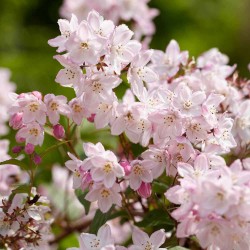
Breeders have tried and brought out many types and varieties of deytsiy. MirSovetov call the most winter-hardy ones:
- Deytsia small-flowered (or Amur) is a deciduous shrub with open branches, up to two meters high. During flowering on it appear white corymbose inflorescences, odorless.
- The action is slender (or elegant) - the bush has a rounded shape, its height is not more than 150 cm. On the arcuate shoots are oblong-lanceolate, with a pointed tip leaves, the edge of which is serrated. White flowers are collected in erect brushes.
- Deytion rough (another name - stellate) - on its egg-shaped leaves there are numerous hairs. Shoots from one to two and a half meters. In the period of flowering they appear erect brush with white or pinkish stellate flowers.
- Deutsia Lemoine is a hybrid shrub, its height is up to two meters. Flowers are snow-white, large, form paniculate inflorescences.
- Deytsiya pink - low (up to a meter) hybrid shrub, in bell-shaped flowers pink color, they are collected in short brushes.
Interesting varieties:
- "Candidissima" (buds with a scarlet shade, and then large flowers, white);
- "Vaterer" (outside the flowers are carmine, and inside - white);
- "Captivity" (outside the flower is pinkish, and inside - white);
- "StrawberryFields" (with large bright pink "bells").
Where to place the action?
The place where the action will grow should meet these requirements - well lit, but protected by something from the burning rays of the sun in the heat. These shrubs do not like drafts, but they will like the light warm breeze. There is no flooding and strong moisture. It grows beautifully and blooms magnificently on neutral soils, loose, breathable, enriched with essential nutrients.
Landing deytion

For planting, try to acquire those instances of action that have a well-developed root system, look healthy and strong. Plant them in the garden or on the local territory in early spring (when the buds on the branches have not yet blossomed) or in the fall (one and a half months before the onset of cold weather). The approximate size of the landing pit is 50x50x50 cm. Place a drain on the bottom. Take to fill the pit humus, compost, garden soil, ashes (about 1-2 large glasses), lime (about 300 grams), 100 grams of Nitrophoska. All of the above mix well. If your sapling roots look dried, then hold it for two hours in water, where they added "Kornevin". There are gardeners who first, before planting, put the roots in a so-called clay mash. In a hole on the hill, arrange the seedlings of the deuterium so that the root collar is slightly below the ground (1-2 cm). Then its roots will not bare, even if the earth proyadet. After tamping up the soil, the sapling needs abundant watering (about 5 liters) and mulching of the nearby ground (the thickness of the mulch layer is 5 cm). If you have several seedlings, then between them there must be a distance of at least two meters.
The first weeks after planting, make sure that the soil under the sapling was moistened on time, then it will quickly start and grow. Then the action can be watered once or twice a month. These shrubs calmly endure periods of short summer droughts. Usually, 5 to 10 liters of water is poured under the bush. Of course, the "swamp" is not necessary to arrange. After watering the surface of the ground under the plant gurgle. Loosening the soil helps air to flow into the layer where the roots are located. At the same time when loosening, remove and weeds.
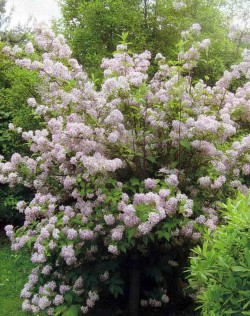
The aboveground part of the deuterium is large, so the bush needs a constant supply of nutrients. In the spring, when you have pruned, add diluted solutions under the action - kuryak or mullein. MirSovetov emphasizes that these solutions must be fermented and divorced. In order not to burn the young roots, first moisten the soil under the bush and then fertilize. If you do not have organics, then use a glass of ash and diluted full mineral fertilizer, for example, Kemira Universal will do.
Hold a second dressing when you notice the swelling of the buds, again using organic fertilizers or a mineral complex.
The third dressing is appropriate in the midst of flowering, then it is necessary to introduce phosphorus-potassium complexes.
If in July and August you notice that the green mass is eaten by caterpillars, then use bioinsecticides, “Decis”.
Another important step in the care of the action - it is pruning. It depends on it how your action will bloom next season. In the spring of each year, they first make a sanitary pruning, while the frozen shoots, diseased branches, and dried ones are removed. If the shrub is an adult, then about 20% of the old branches are cut out of it (at their base).
The second pruning is carried out after flowering. Then you need to trim the bloomed shoots to the place of the first side branch.
The third pruning is carried out in the autumn, then the bloomed, young shoots are trimmed if necessary, the shape of the bush is formed, the degree of its thickening is regulated.
When the bush is aging, it can be rejuvenated. In this case, all ground shoots are cut. Then during the summer season young shoots will grow out of the root shoots. In the fall, leave five of them, and cut the rest to the ground.
Now gardeners are trying to acquire those varieties of actions that are resistant to frost. And yet, in the first years of life it is desirable to cover all the deformations, bending down to the ground. Or tie the branches, wrapping them with spruce branches, fixing the branches with ropes. From above you can wear a large bag or wrap with sacking, spunbond. And throw more snow in the winter to these bushes - it will be a “blanket” for them. In the spring, shoots are freed from cover; wetting of shoots cannot be allowed!
If you want to multiply the action, then use the following methods:
- division of the old bush;
- pinching cuttings to the soil;
- green cutting (cuttings cut in June, their length should be 20-25 cm);
- grafting with lignified cuttings (they are cut in autumn, length - about 15 cm);
- seeds (used very rarely).
The actions decorate the dacha plots, alleys, parks, sanatoriums. You can create a beautiful composition by planting deuteria next to fir, thuja, juniper, spiraea, weigela, forsythia, and then adding more hosts and geyhery. These unpretentious shrubs are suitable for planting in the front garden near the house, because they are resistant to polluted air, drought, and put up with penumbra.
The genus includes about fifty species. Especially popular are decorative unpretentious garden forms and varieties that have high winter hardiness, not only with simple flowers, but also with double flowers.
Deytion rough
Rough, or stellate, or rough (D. scaba) is represented by a small and very elegant shrub. Shoots are covered with gray or reddish-brown, peeling bark over time. Leaves dull, green or yellowish-brown staining. The flowers are white or pink, collected in a beautiful and narrow racemes. It is used in single and group plantings. Differs in insufficient frost resistance. Belotsvetkovy and densely leafy “Candidissima” and with yellowish-white flowers “Marmorata” are among the most popular varieties.
Deytion elegant
Elegant or slim (D.gr.ilis) is characterized by small size. The height of the aerial parts can vary between 50-120 cm. A distinctive feature is the neat, bushy form of perennial, as well as early and abundant flowering.
In the flowering phase, the species enters the second year after planting. White flowers, collected in elegant racemes that look spectacular against the background of oblong-lanceolate foliage. View used in the design of borders and in group plantings with tall plants.
Deytsiya pink
Pink (D. rosea) is a hybrid form derived from the species purple and elegant. The height of the ornamental shrub perennial does not exceed a meter. The flowers are characterized by a very attractive bell-shaped form with two-colored petals. The lower part of the petals has a pink color. The upper part of the petals pinkish-white.
The whitest forms are white inflorescences with a diameter of up to 10-12 cm, consisting of double flowers 30 mm in diameter. The period of active flowering is in the middle of summer. The height of the aerial part reaches two meters.
Deytsia Amur
Amur, or small-flowered (D. amurensis) is represented by sprawling shrubs up to two meters high. The aerial part is covered with brown or grayish bark. The foliage is elliptical, with finely serrate edges and a point. Leaf plate with pubescence. In the fall, the leaves have a brownish-yellow color. Flowers numerous, white coloring, with a diameter up to centimeter, collected in inflorescences of corymbose type.
D. hybrid
The hybrid deytsey is represented by artificially bred species, obtained by crossing several different varieties at once. Such hybrid forms adopt the best features from the parent pair and differ in the increased resistance to adverse external factors.
D. gorgeous
Gorgeous or lush, or hybrid (D. x magnifica) - this is a very popular hybrid form in homestead floriculture, obtained as a result of the work on the crossing of a rough deformation and a wormorite deformation. Upright shrub up to 2.5 m tall with arcuate shoots. The foliage is oblong-ovate, bright green staining. The flowers are numerous, terry type, white, collected in large and lush inflorescences, blooming in large quantities in the middle of summer.
D. terry
Terry deytion - the plant is very decorative and it is precisely such varieties that are increasingly preferred by flower growers in the Moscow region, where wintering of perennial does not present any particular difficulties. The most popular varieties are large-shrub. "Plena" and vertically growing white flowers "Pride of Rochester".
Deytsia Mount Rose, Pride of Rochester, Strawberry Glade and other popular varieties
- Sort "Mont Rose" with white or pink, terry flowers. A large shrub perennial plant reaches a height of 2.5 meters. The foliage is dark green in color; in the autumn period it acquires an attractive yellowish-red hue. Perennial blooms from June to July and grows very well and develops on all types of soil.
- Pride ochester(Pridé Rocasherr) belongs to the category of terry dejtion with a height of the aerial part up to three meters with a width of up to 2.5 m. The flowers are very decorative, of a terry type, of snow-white coloring;
How to plant action (video)
- Amazingly beautiful variety "Strawberry Glade" forms very large flowers, collected in large and lush paniculate inflorescences. Differs in whitish-pink coloring of petals. Shades can vary from rich crimson tones to lingonberry or light lilac staining. The average height of the shrub does not exceed one and a half meters;
- For grade "Pink Mountain" very beautiful and plentiful flowering is characteristic. Spreading perennial one and a half meter long shrub has elegant hanging side shoots, which are literally covered with delicate pink flowers, gathered in raceme-shaped inflorescences. It is characterized by winter hardiness, and when freezing in extreme cold it can quickly recover from the root system.
- Strawberry Fieldsup to one and a half meters high, it attracts attention with very beautiful, elegant whitish-pink flowers, which look spectacular against the background of oblong-lanceolate leaves. The shoots of shrub perennial have an attractive arcuate shape. Active bloom occurs in June-July, when large buds of white-pink color are formed with a clearly visible red heart;
- Captivity is a shrub medium-growing perennial with green foliage and white or pink flowers that bloom in late May or early June. Obrazk plant is practically not required;
- Turbilon Rouge refers to the popular and very common hybrid forms up to two meters in height or slightly higher, with oval-ovoid foliage and snow-white terry flowers that bloom in early summer;
- Hybrid view of Lemoine the result of the crossing of species is graceful and small-color. Belongs to the category of early, and flowering begins in late spring and early summer. White flowers, gathered in lush and fairly large pyramidal inflorescences. Differs in excellent winter hardiness.
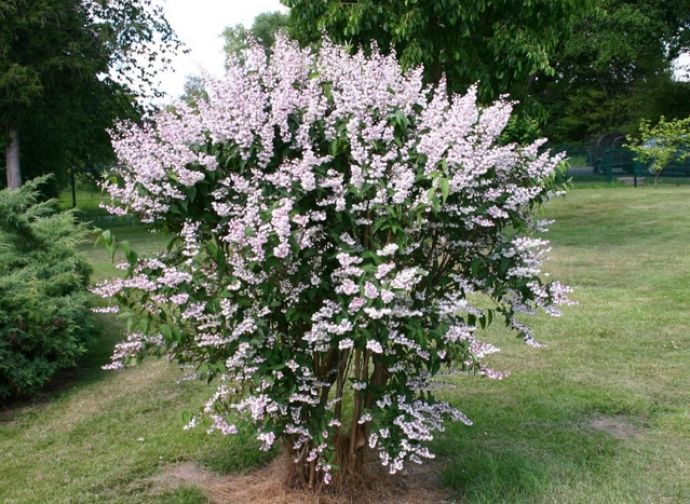
Varieties and types
In the wild form is represented in China and Japan. It owes its name to the rough foliage completely covered with small villi. The height of this species is up to 2.5 m, the exfoliating bark of the stems is colored red or gray-brown, the brushes of the inflorescences of white or pinkish shade grow up to 12 cm in length.
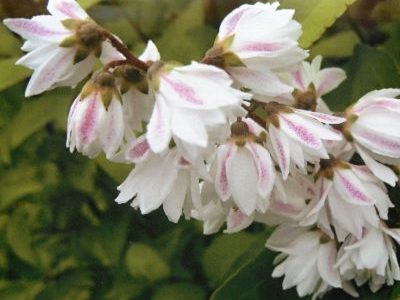
- Unusually spectacular garden forms with dimensional flowers, under the weight of which the plant bends in an arc, while they are considered among the most winter-hardy. These include the decorative form. deutzia Terry with terry white flowers from the inside and pink flowers from the outside.

From the highlands of the Land of the Rising Sun, it is notable for a relatively small height (up to 1.5 m), spherical bushes and rich flowering. The leaves are pointed, up to 6 cm in length, bare at the bottom and covered with hairs from above, replacing the color from light green in summer to yellow in autumn. Flowers of pure white form straight tassels up to 9 cm long.
The beginning of the flowering period of this type is dated 2 weeks earlier than the previous one, and its duration is 25-35 days.
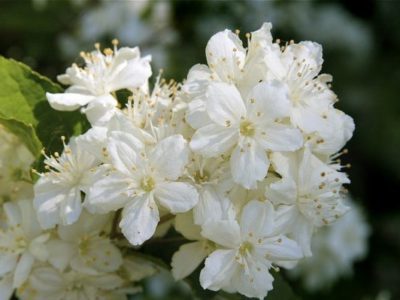
- - is one of the smallest with a height of up to 80 cm and a crown width of up to 100 m. The flowering is very decorative, begins in late spring. In the fall, the foliage of the variety becomes red-purple.
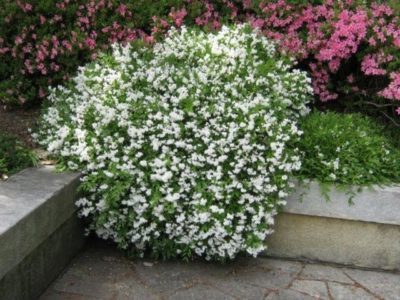
- medium height (up to 2 m) view with brownish (later gray) bark of the stems, oval pubescent leaves up to 6 cm in length. The foliage color in spring and summer is bright green or gray-green, and in autumn it is brownish-yellow. The inflorescences are formed by white flowers and are up to 7 cm wide. In natural form, it is found in the Far East, North Korea and China.
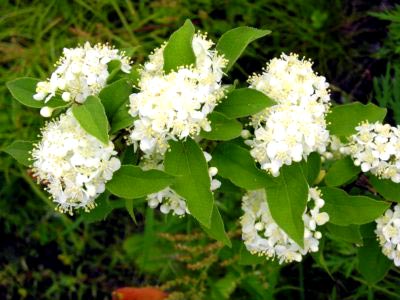
- up to 1.6 m in height, with a lush spherical crown, white flowers up to 2 cm in diameter, arranged in straight panicle inflorescences. Begins to bloom in May.

- Ornamental varieties are especially popular among gardeners. letion of Lemoine Strawberry Fields (with pale pink inside and crimson flowers outside)
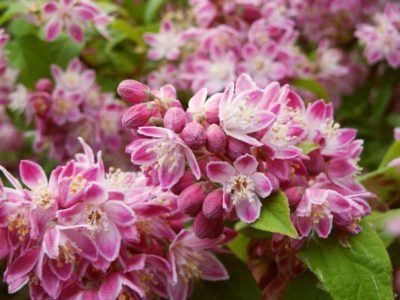
- mont rose (with not less interesting overall flowers of bright pink shade and slightly twisted petals).
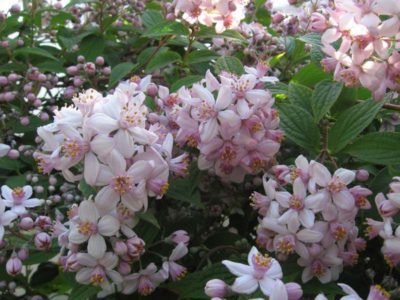
It is a very hardy hybrid rough, inheriting its height. The inflorescences in the form of umbrellas up to 10 cm long are collected from white terry flowers, giving a very lush bloom for 3 weeks.
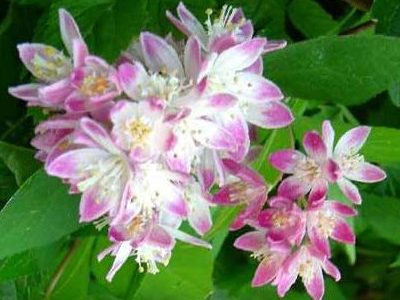
- with strong straight stems up to 1.8 m in height, dimensional red-white flowers in racemes and highly decorative bark blooms in early to mid-summer and looks great even in late autumn and winter.
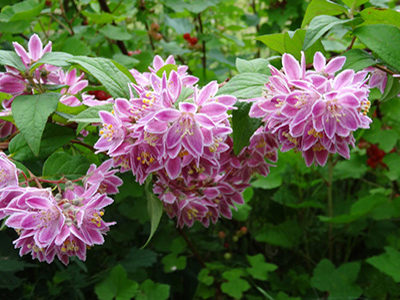
- A hybrid based on an elegant. Very compact (up to 1 meter in height) with dark-green leaves and flowers with a diameter of one and a half centimeters.
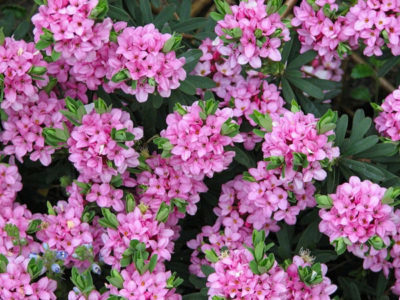
- One of the most attractive hybrids, up to 2 m tall, blooming in the first half of summer. Snow-white double flowers up to 3 cm in diameter, gather in inflorescences up to 12 cm long. Under optimal conditions of growth and with proper care can live as much as 50 years!

Deytsiya landing and care in the open field
During the landing the actions should be determined at a distance of 2.5 m from each other and 2 m between the rows. Preferred open or slightly shaded places from the midday solstice.
Planting is carried out at a depth of 40-50 cm, leaving the root collar flush with the ground. To stimulate flowering, plants are fertilized with liquid manure in the amount of 5-6 liters per one.
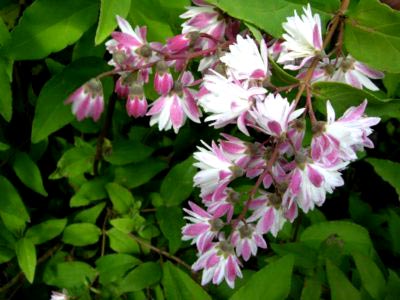
Watering the action
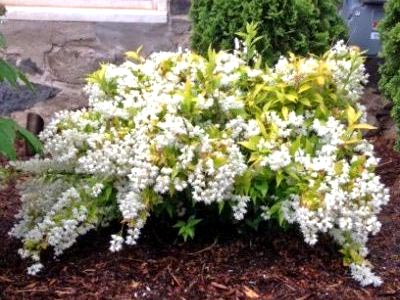
Ground for action
Deytsiya prefers fertile neutral (with acidity index 5-8) soil. It may be loamy, but by no means drained moisture accumulating elements, because the stagnation of soil moisture affects the development of the plant.
The ideal substrate for adult activities is a mixture of river sand, humus and peat (or compost) in proportions of 2: 2: 1. For the reasons described above, it is also extremely not recommended to locate the plant in places where groundwater flows close to the ground.
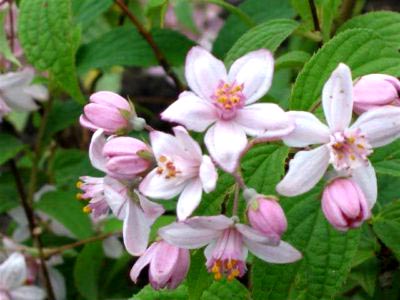
Deytion transplant
The root system of deicia includes 1-2 large roots stretching in depth, and many small, fibrous roots. It is the latter that give deities an ability to cope well with a transplant. This procedure is carried out in the spring, for which the bush is carefully excavated, keeping the structure of the earthy coma as far as possible (the crown contour serves as a guideline for the joint of the spade with the ground).
Before planting a plant with a lump in a new place, the soil of the planting pit is fertilized with complex mineral fertilizer (20-30 g). It is especially important to consider the location of the root collar during transplantation, so that it is not too deep and, at the same time, does not rise above the level of the soil cover.
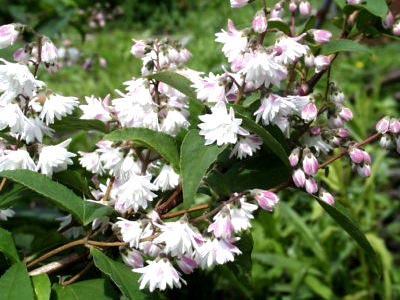
Fertilizers for action
Abundant fertilizing deytiyu need to perform only when planting, then it requires only 3-4 liters of liquid manure during flowering once a month. Additionally, it is recommended to feed it twice with a complex mineral fertilizer (100-150 g per bush) twice per season.
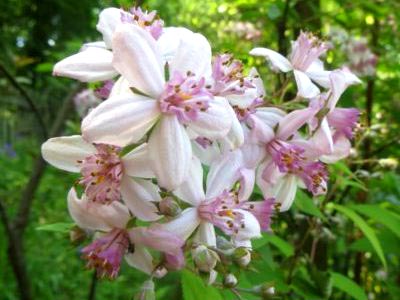
Crop deatii
Pruning is carried out 2 times a year - in the spring (removal of frozen, dry, cracked and wrinkled branches) and in the summer (after flowering, the main pruning). Summer pruning involves shortening the stems by one third, with the concomitant adjustment of the bush.
In the event that the appearance of the action is completely inconsistent with the desired one, you can safely cut it to the very base, leaving one stump. These actions will have a stimulating effect on the activity of growth of root stems, which will eventually lead to the emergence of a new lush bush as early as next year.
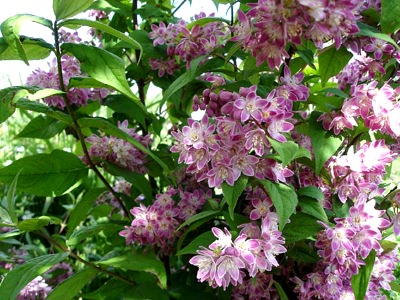
Deytion shelter for the winter
Taking into account the fact that the action is a rather winter-hardy plant, by winter it should be covered with a light dried leaf, forming a layer of 10-20 cm. It is not difficult to bend the shoots of low specimens to the ground, whereas with tall actions it is more difficult.
At the end of the autumn, the bushes are tightly tied with a suitable breathable material (for example, synthetics used in sugar bags), while the leaves that have not yet fallen play the role of additional cover. This non-labor-intensive method achieves almost complete preservation of the bushes, even at temperatures as low as -30 C.
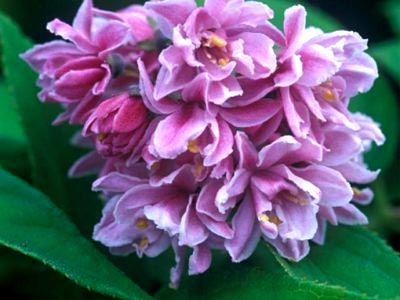
Propagation of the action of seeds
For reproduction of seeds, seeds are sown in spring without preparatory treatment. When sowing, it is quite sufficient to press the seeds firmly to the ground, without closing them. After 3 weeks, sprouting will occur, in the future germination can last for up to 3 years.
Seeds are kept in cool rooms, well corked in vessels or sealed in plastic bags. To avoid drying out of seeds and seedlings, it is recommended to use sowing boxes for sowing. 1-year-old seedlings, subject to the influence of low temperatures, you need to organize a shelter, they should dive in the spring. In favorable conditions, flowering can occur in the 3rd year.
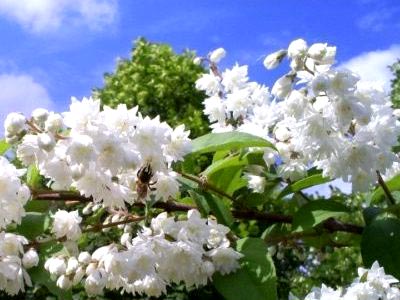
Detion reproduction cuttings
Green grafting is the most optimal method of propagation of actions, characterized by rooting 90-100% at an ambient temperature of 15-30 C and artificial fog (due to spraying from nozzles).
8 - 10 cm from adult large stems are cut into cuttings in late spring or early summer. It is advisable to treat the cut with a root formation stimulator. Sand peat and river sand are equally suitable for soil mixture.
You should deepen the cuttings by half a centimeter, maintaining a small tilt, and sprinkle with a 3-cm layer of sand. After 2 years, seedlings can be planted in a stable place.
Lignified cuttings need to be prepared at the end of autumn, when the plant is at rest. Cuttings 15–25 cm long, with 3-5 buds on each, are tied together in bundles of 10–15 pieces and, in an upright position, are almost completely covered with moistened sand. So they should be stored until spring in the basement, then can be grown by analogy with green cuttings.
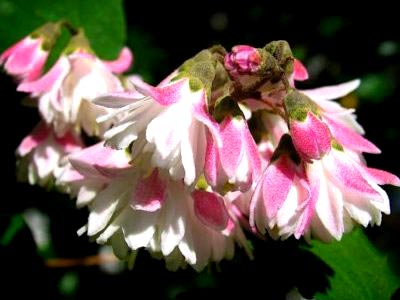
Diseases and pests
Deytsiya refers to resistant to diseases and pests of plants. It is not a frequent case that the foliage is eaten by a bumble-nosed proboscis, which is eliminated by treatment with a 0.15 percent solution of phthalophos or karbofos.
